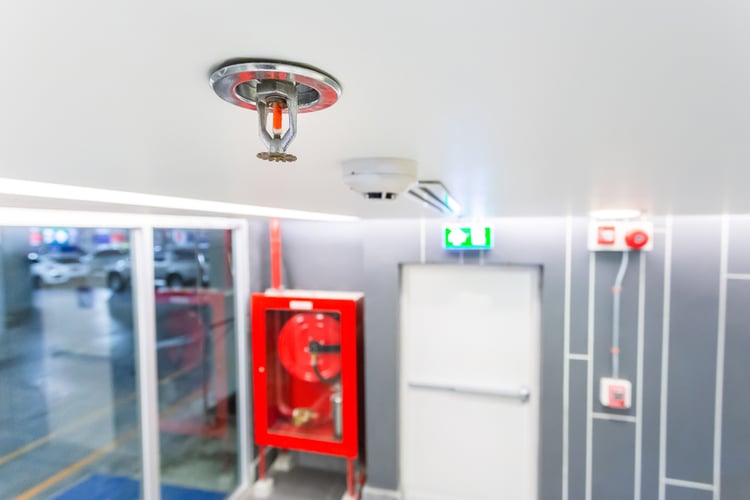Fire sprinkler systems are essential for making building interiors safe. Our previous article on the topic provided an overview of how fire sprinklers work, debunking some common myths about them that have been popularized by movies and TV series. In this article, we will compare the two main types of piping configurations used with fire sprinklers: wet piping and dry piping systems.
As you can guess from the names, wet pipe systems are permanently filled with water, while dry pipe systems are filled with air and the water is held in by a valve. Wet-pipe sprinkler systems are the standard option used in most residential and commercial environments, while dry-pipe systems are primarily for special applications where water-filled piping would be impractical.
Depending on the characteristics of your building, sprinkler system installation may be mandatory by July 1, 2019, in accordance with Local Law 26 of 2004. Obtain a professional assessment of your property to determine whether LL26 applies and the scope of the necessary work, if applicable.
Looking for Sprinkler System Services?
Contact us
Wet pipe fire extinguishing systems

As mentioned previously, wet pipe sprinkler systems have their pipes permanently filled with pressurized water. This has a purpose: if any individual sprinkler opens in response to heat, water flows immediately and at a moderately high pressure. For this reason, wet pipe installations have the fastest response of all sprinkler system configurations – reaction time is not dependent on the distance between the activated sprinkler and the water supply.
Wet pipe sprinkler systems have the lowest cost and quickest response, making them the preferred option in a wide range of applications. They also have very simple maintenance needs. The main limitation of this fire sprinkler configuration is that the water in the piping can freeze at low temperatures, limiting its use in cold environments (natural or artificial).
There are also special applications where flammable substances are stored, and the sprinkler system may be required to spray water from all sprinklers at once. This is not possible with a wet pipe system: water is held in each sprinkler head and they are activated individually by localized heating, so there is no way to activate them all at once.
Wet pipe systems are easier to restart after responding to a fire. Just replace the sprinklers that opened and refill the pipe with water.
Dry pipe fire extinguishing systems

In their most basic configuration, dry-tube sprinkler systems respond just like their wet-tube counterparts: the sprinklers are individually activated by heat. However, the piping is filled with compressed air or nitrogen instead of water, and a valve controls water entry into the system. When a sprinkler is activated, compressed air is released and the pressure relief opens the valve, allowing water into the system. However, dry pipe systems have a slower response than wet pipe systems because water must travel from the source to the activated sprinkler. As the distance between the two points increases, so does the response time.
This system configuration is recommended when a wet piping system is prone to freezing. Otherwise, the lower cost, simpler maintenance, and faster response of a wet-pipe sprinkler system are preferred. Dry pipe systems are also more difficult to restore once they are activated, since the piping must be drained of all water and then refilled with compressed air or nitrogen.
The above description is for standard dry pipe sprinkler systems, but there are two variants for special applications: pre-action systems and deluge systems .
Pre-action fire sprinkler systems

A pre-action sprinkler system is very similar to a normal dry pipe system, but two conditions must be met before the system will discharge water:
- A fire, heat or smoke detector independent of any individual sprinkler opens the main valve, filling the system with water.
- At this point, the fire sprinkler system functions like a wet pipe installation: if any sprinkler is activated by heat, water is discharged.
Pre-action sprinkler systems are very common in cold storage applications where a wet piping system is not viable because the water freezes. Pre-action systems are also common in applications where materials or equipment are very vulnerable to water damage – think fire protection in data centers, art galleries and libraries.
In this type of sprinkler system, it is very important to keep the main valve and the sensors that activate it in ideal conditions. If the main valve doesn't open during a fire, the activated sprinklers will do nothing to control it.
Deluge fire extinguishing systems

In this system configuration, all sprinklers are permanently open while a valve holds back the water. As a result, all sprinklers release water when the valve opens, regardless of where the fire is located. This system configuration is used in locations that are especially vulnerable to fires, such as petroleum processing facilities, power plants, and chemical storage areas.
The valve is activated by a fire detection system, which can respond to both smoke and heat. Deluge sprinkler systems are not used unless the application is very fire sensitive, as they are capable of causing widespread water damage. When this fire sprinkler configuration is specified, it is for applications where fire can spread quickly and violently.
Conclusion
Each of the types of fire sprinkler systems described here is suitable for different applications, so it is very important to select the correct system for each building. Considering that fire protection is necessary for the safety of building interiors, and also that New York codes are very demanding when it comes to fire sprinklers, we strongly recommend that you obtain a professional opinion from qualified fire protection engineers .
It is important to note that automatic sprinkler systems are only one element of fire protection. There are also systems such as fire alarms and smoke control equipment, which also play important roles in fire protection.

